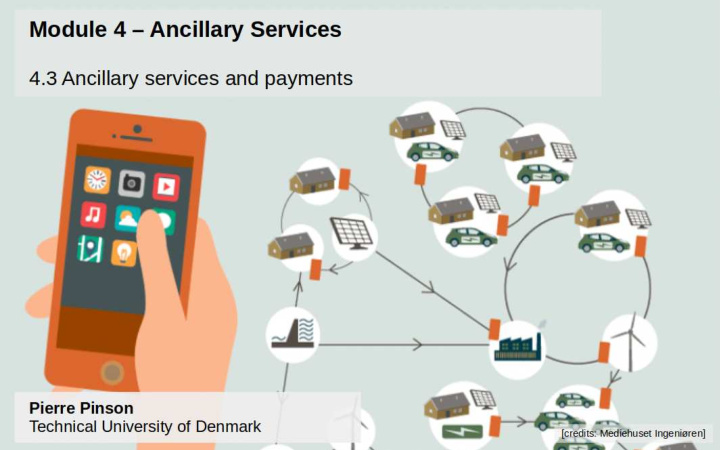



Ancillary services in Denmark Denmark is originally connected to two different power systems with different operational practice Ancillary services are then different in DK1 and DK2... Energinet, “Ancillary services to be delivered in Denmark – Tender conditions”, October 2012 (link). 2/15
Ancillary services in DK1 and DK2 (with focus on frequency-related services) DK2 DK1 Frequency-controlled Primary reserves normal operation reserves (FNR) Secondary reserves (Load Frequency Frequency-controlled Control) disturbance reserves (FDR) Manual reserves Manual reserves 3/15
Primary reserves (DK1) There is an overall need for + / − 3.000MW of primary-type reserves over continental Europe (following ENTSO-E assessment and recommendation) This amount (capacity) is shared among all system operators For DK1, this share is of + / − 27MW Response to frequency de- viation 4/15
Primary reserve activation and market (DK1) Required characteristics of reserve response (prior certification) daily day-ahead auctions inflexible demand (27MW) need for upward and downward capacity merit order on capacity offers energy is not considered ( Energy-neutral service ) 5/15
Primary reserve payment (DK1) For market participant i : Revenue G i = P G i λ c where P i : accepted capacity λ c : clearing price In this example: G 1 : 10MW × 10DKK/MW = 100DKK G 2 : 5MW × 10DKK/MW = 50DKK G 3 : 5MW × 10DKK/MW = 50DKK (out of the 6MW originally offered ) others: 0DKK Here, only generators are considered... Though demand could also provide such services (e.g., batteries, electric boilers) 6/15
Secondary reserves (DK1) Two distinct goals: Relieve the primary reserve which has been activated Restore any imbalance on the interconnections The capacity requirement for DK1 is of + / − 90MW (following ENTSO-E assessment and recommendation) 7/15
Secondary reserve market (DK1) (1) Payment for capacity AND for energy (This is not an energy-neutral service!) Capacity purchased on a monthly basis combined and symmetrical upward and downward products based on bilateral contracts (negotiated, non-public) → Result for Generator G i : P G (MW) and λ G i (DKK/MW) i 8/15
Secondary reserve market (DK1) (2) Energy All energy ∆ E i generated/consumed is to be paid for (for given generator G i ) Two reference prices are to be considered: day-ahead price λ S for that time, as well as balancing price λ B (from balancing market) Minimum revenues are ensured by always having a spread of at least 100 between day-ahead and balancing prices In practice, in the upward regulation case: ( λ S + 100)∆ E i if λ B < λ S + 100 , � Energy revenue( G i ) = λ B ∆ E i otherwise And, in the downward regulation case: � ( λ S − 100)∆ E i if λ B > λ S − 100 , Energy revenue( G i ) = − λ B ∆ E i otherwise The (negative) revenue in the downward regulation case consists in buying back energy that was already sold through the day-ahead market! 9/15
Secondary reserve payments (DK1) Example (for a given time unit, upward regulation cases): � is to generate 50MWh through the day-ahead market ( λ S = 200DKK/MWh) RT R � has a contract for secondary reserve provision, with P G RT = 10MW, λ G RT R RT =20DKK/MW 2 illustrative cases: Need for upward regulation, energy fully delivered, balancing price λ B = 250DKK/MWh, � ) = 10 × 20 + 10 × (200 + 100) = 3200DKK R Revenue( RT Need for upward regulation, energy half delivered, balancing price λ B = 320DKK/MWh, � ) = 10 × 20 + 5 × 320 = 1800DKK R Revenue( RT 10/15
Secondary reserve payments (DK1) Example (for a given time unit, downward regulation cases): � is to generate 50MWh through the day-ahead market ( λ S = 200DKK/MWh) RT R � has a contract for secondary reserve provision, with P G RT = 10MW, λ G RT R RT =20DKK/MW 2 illustrative cases: Need for downward regulation, energy fully “consumed” (/reduced), balancing price λ B = 150DKK/MWh, � ) = 10 × 20 − 10 × (200 − 100) = − 800DKK R Revenue( RT Need for downward regulation, energy half “consumed”, balancing price λ B = 50DKK/MWh, � ) = 10 × 20 − 5 × 50 = − 50DKK R Revenue( RT 11/15
Manual (/tertiary) reserves (DK1) The full timeline for reserve products daily day-ahead auctions varying demand need for upward and downward capacity merit order on capacity offers energy is paid for at the balancing price λ B 12/15
Tertiary reserve payments (DK1) Example (for a given time unit, upward regulation cases): � is to generate 50MWh through the day-ahead market ( λ S = 200DKK/MWh) RT R � gets cleared to provide tertiary reserves, with P G RT = 20MW, λ G RT R RT =2DKK/MW 2 illustrative cases: Need for upward regulation, energy fully delivered, balancing price λ B = 250DKK/MWh, � ) = 20 × 2 + 20 × 250 = 5040DKK R Revenue( RT Need for upward regulation, energy half delivered, balancing price λ B = 320DKK/MWh, � ) = 20 × 2 + 10 × 320 = 3240DKK R Revenue( RT 13/15
Tertiary reserve payments (DK1) Example (for a given time unit, downward regulation cases): � is to generate 50MWh through the day-ahead market ( λ S = 200DKK/MWh) RT R � gets cleared to provide tertiary reserves, with P G RT = 20MW, λ G RT R RT =2DKK/MW 2 illustrative cases: Need for downward regulation, energy fully “consumed” (/reduced), balancing price λ B = 150DKK/MWh, � ) = 20 × 2 − 20 × 150 = − 2960DKK R Revenue( RT Need for downward regulation, energy half “consumed”, balancing price λ B = 50DKK/MWh, � ) = 20 × 2 − 10 × 50 = − 460DKK R Revenue( RT 14/15
Recommend
More recommend